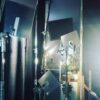Cinematography landscape is developing at a fast pace and as we no longer use a whole truck of light there is place for a wider creativity when it comes to the art of capturing unique tabletop shots. In our new series of DoP to DoP talks – Mikołaj Krawczunas, a DoP passionately interested in latest technology, invites various cinematographers to the table, and asks for some little behind the scenes of their work. His first guest is Winnie Heun, a Berlin based DoP specializing in tabletop.
Winnie, how would you describe your lighting approach?
For me contrast is everything. I am not a fan of too much fill light and I love hard Tungsten beams. But overall speaking my lighting approach on things is changing constantly due to the fact that I am changing myself too, I guess. On live action and tabletop shots there is no right way of lighting a scene or product. I hate routine, so I try to give every shot a new eye. At the moment I am using reflectors in various sizes such as the CRLS system. I built my own reflectors, though.

I prefer LED fixtures to avoid too much heat on set. I am testing new lighting fixtures a lot such as the new Laser from Sumolight or Moving Lights. The moving lights I like a lot. They are coming more from show lighting and for that you need a good dimmer board operator and a gaffer who knows what he/she is doing. On high speed shots I am able to use spining gobos during the take, that makes it less static. I like that effect especially on pouring shots.
Sometimes it’s great to switch off certain lights after you are down lighting a scene. It’s good to see what certain fixtures do but switching a few of them off might look even better.
Many times less is more and I think my lighting setups are getting easier and easier. I am not a big fan of huge equipment orders just to play safe.
I try to order what I’ll need and not more. Call it production friendly or not wasting resources. Very often we used every piece of equipment on the trucks.
My goal is to make the director happy and to bring his/her vision to life. Sometimes I can contribute more and sometimes less. It really comes down to how specific the director’s vision is. I’ve been lucky so far.
What is your favorite tabletop commercial you’ve worked on and why?
I very much enjoyed the commercial shoot for a Mexican hoover brand in Guadalajara. I shot the live action part and the tabletop part.

